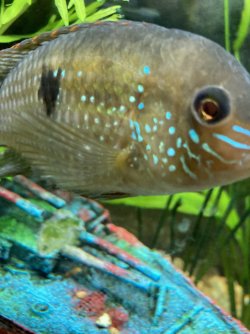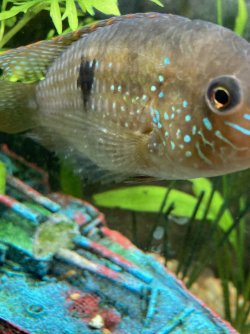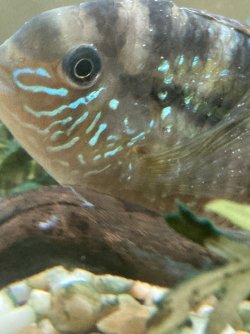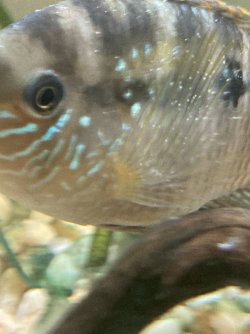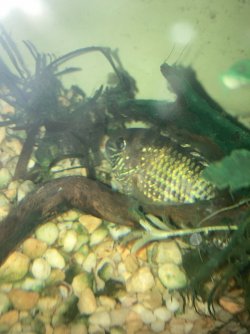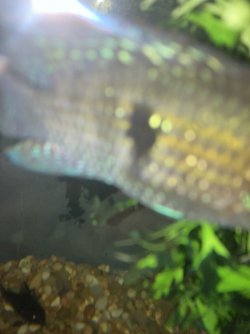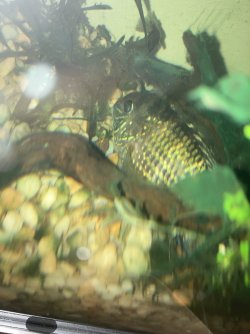ThatDonutMan
New Member
Tank size: 45 Gallon
Tank age: 1 1/2 Years
PH: 6.7
Ammonia: 0ppm
Nitrite: 0ppm
Nitrate: 20ppm
kH: Can't Test For
gH: Can't test For
Tank temp: 70F
Hello fishforums! My Blue Acara Cichlid about a week ago had a white spots appear on her fin (see image). The fin seems to be affecting her, she has been holding the fin close to her while moving the other one. She also has been swimming and acting more frantic than normal, darting more often at other fish and darting away when I walk near the tank. The tank is planted with a recent addition of a bristlenose pleco and a large piece of drift wood, which both looked all clear when I purchased. The other fish in the tank seem ok with no spots on any of their fins. I have some ideas on what it could be which I hope you can confirm or deny, but I am still uncertain. Some of them being Lymphocytes Virus, Epitheliocystis, Cauliflower Disease, or just ich (very unlikely it has not spread to the body and the spots are not uniform but idk). I thank you for your time and I hope you can help me help my fish.
Volume and Frequency of water changes: about 50% per week
Chemical Additives or Media in your tank: API Leaf Zone
Tank inhabitants: 5 Black Skirt Tetras, 4 Cory Catfish, 1 Blue Acara Cichlid, and 1 Bristlenose Pleco
Recent additions to your tank (living or decoration): 1Piece of Drift Wood
Exposure to chemicals: none
Digital photo (include if possible):
Tank age: 1 1/2 Years
PH: 6.7
Ammonia: 0ppm
Nitrite: 0ppm
Nitrate: 20ppm
kH: Can't Test For
gH: Can't test For
Tank temp: 70F
Hello fishforums! My Blue Acara Cichlid about a week ago had a white spots appear on her fin (see image). The fin seems to be affecting her, she has been holding the fin close to her while moving the other one. She also has been swimming and acting more frantic than normal, darting more often at other fish and darting away when I walk near the tank. The tank is planted with a recent addition of a bristlenose pleco and a large piece of drift wood, which both looked all clear when I purchased. The other fish in the tank seem ok with no spots on any of their fins. I have some ideas on what it could be which I hope you can confirm or deny, but I am still uncertain. Some of them being Lymphocytes Virus, Epitheliocystis, Cauliflower Disease, or just ich (very unlikely it has not spread to the body and the spots are not uniform but idk). I thank you for your time and I hope you can help me help my fish.
Volume and Frequency of water changes: about 50% per week
Chemical Additives or Media in your tank: API Leaf Zone
Tank inhabitants: 5 Black Skirt Tetras, 4 Cory Catfish, 1 Blue Acara Cichlid, and 1 Bristlenose Pleco
Recent additions to your tank (living or decoration): 1Piece of Drift Wood
Exposure to chemicals: none
Digital photo (include if possible):


